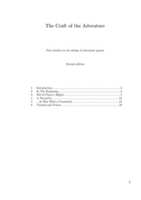#讀嘛讀嘛

The Craft of the Adventure by Graham Nelson
這本30多頁的論文雖然是1990年代的產物,但內容依舊適用於現今的文字解謎遊戲/RPG Maker遊戲,提出了不少經典但有用的例子,非常適合新手閱讀。
市面上都是電影編劇的工具書,大家也都推薦遊戲開發者看「救貓咪」一類的電影或寫作編劇書,不過電影和遊戲是不同的創作媒介,實際操作起來還是有差別,因此我認為這是相當好、針對「遊戲敘事」的入門書。
留言收摘錄⬇️
The Craft of the Adventure by Graham Nelson
這本30多頁的論文雖然是1990年代的產物,但內容依舊適用於現今的文字解謎遊戲/RPG Maker遊戲,提出了不少經典但有用的例子,非常適合新手閱讀。
市面上都是電影編劇的工具書,大家也都推薦遊戲開發者看「救貓咪」一類的電影或寫作編劇書,不過電影和遊戲是不同的創作媒介,實際操作起來還是有差別,因此我認為這是相當好、針對「遊戲敘事」的入門書。
留言收摘錄⬇️
Magic Spells
If there are spells (or things which come down to spells, such as alien artifacts) then each should be used at least twice in the game, preferably in different contexts, and some many times. But, and this is a big 'but', the majority of puzzles should be soluble by hand
If there are spells (or things which come down to spells, such as alien artifacts) then each should be used at least twice in the game, preferably in different contexts, and some many times. But, and this is a big 'but', the majority of puzzles should be soluble by hand
- or else the player will start to feel that it would save a good deal of time and effort just to find the "win game" spell and be done with it.
Magic has to be part of the mythology of a game to work.
Magic has to be part of the mythology of a game to work.
Research
Design usually begins with, and is periodically interrupted by, research. This can be the most entertaining part of the project and is certainly the most rewarding,
... History crowds with fugitive tales. Finding an eyewitness account is always a plea-
sure:
Design usually begins with, and is periodically interrupted by, research. This can be the most entertaining part of the project and is certainly the most rewarding,
... History crowds with fugitive tales. Finding an eyewitness account is always a plea-
sure:

Prologue
The prologue has two vital duties. Firstly, it has to establish an atmospherelland
give out a little background information.
Similarly, most games begin with something relatively mundane (the guild-house in 'Sorcerer', Kensington Gardens in 'Trinity') or else they include the exotic with dream-sequences.
The prologue has two vital duties. Firstly, it has to establish an atmospherelland
give out a little background information.
Similarly, most games begin with something relatively mundane (the guild-house in 'Sorcerer', Kensington Gardens in 'Trinity') or else they include the exotic with dream-sequences.
The Middle Game
Some games, such as the original Adventure, are very wide?"there are thirty or so puzzles, all easily available, none leading to each other. Othere. Buch as "Spellbreaker'. are very narrow: a long sequence of puzzles, each of which leads only to a chance to solve the next.
Some games, such as the original Adventure, are very wide?"there are thirty or so puzzles, all easily available, none leading to each other. Othere. Buch as "Spellbreaker'. are very narrow: a long sequence of puzzles, each of which leads only to a chance to solve the next.
So a first-draft design of the middle game may just consist of a rough sketch of a map divided into zones, with an idea for some event or meeting to take place in each, together with some general ideas for objects.
The End Game
End games serve two purposes. Firstly they give the player a sense of being near to success, and can be used to culminate the plot, to reveal the game's secrets. This is obvious enough. They also serve to stop the final stage of the game from being too hard.
End games serve two purposes. Firstly they give the player a sense of being near to success, and can be used to culminate the plot, to reveal the game's secrets. This is obvious enough. They also serve to stop the final stage of the game from being too hard.
As a designer, you don't usually want the last step to be too difficult; you want to give the player the satisfaction of finishing, as a reward for having got through the game.
End Game
In a novelist's last chapter, ends are always tied up (suspiciously neatly compared with real life - Jane Austen being a particular offender, though always in the interests of humour). The characters are all sent off with their fates worked out and issues which cropped up from time to time are settled. So should the end game be.
In a novelist's last chapter, ends are always tied up (suspiciously neatly compared with real life - Jane Austen being a particular offender, though always in the interests of humour). The characters are all sent off with their fates worked out and issues which cropped up from time to time are settled. So should the end game be.
Looking back, as if you were a winning player, do you understand why everything that happened did? (Of course, some questions will forever remain dark. Who did kill the chauffeur in 'The Big Most Sleep’?)
But a good rule of thumb, as any film screenplay writer will testify, seems to be to make the two scenes which open and close the story "book-ends" for each other: in some way symmetrical and matching.